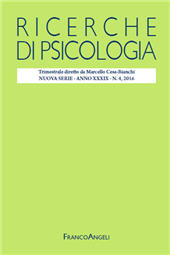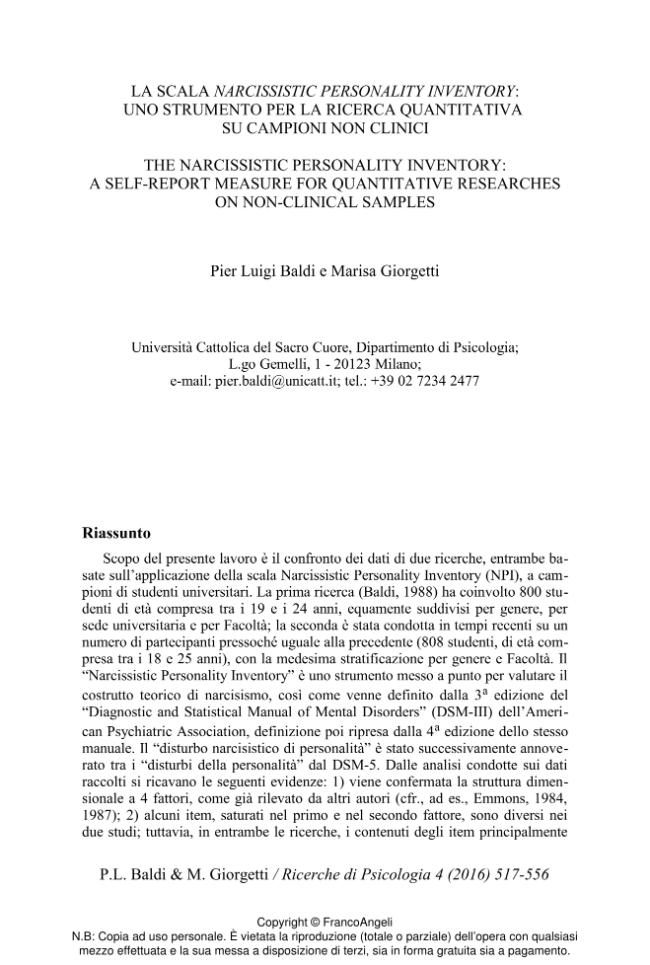2016 - Franco Angeli
Articolo
Versione Digitale
Download | Copia/incolla | Stampa
La scala narcissistic personality inventory : uno strumento per la ricerca quantitativa su campioni non clinici
517-554 p.
- Scopo del presente lavoro è il confronto dei dati di due ricerche, entrambe basate sull'applicazione della scala Narcissistic Personality Inventory (NPI), a campioni di studenti universitari. La prima ricerca (Baldi, 1988) ha coinvolto 800 studenti di età compresa tra i 19 e i 24 anni, equamente suddivisi per genere, per sede universitaria e per Facoltà; la seconda è stata condotta in tempi recenti su un numero di partecipanti pressoché uguale alla precedente (808 studenti, di età compresa tra i 18 e 25 anni), con la medesima stratificazione per genere e Facoltà. Il "Narcissistic Personality Inventory" è uno strumento messo a punto per valutare il costrutto teorico di narcisismo, così come venne definito dalla 3a edizione del "Diagnostic and Statistical Manual of Mental Disorders" (DSM-III) dell'American Psychiatric Association, definizione poi ripresa dalla 4a edizione dello stesso manuale.
- Il "disturbo narcisistico di personalità" è stato successivamente annoverato tra i "disturbi della personalità" dal DSM-5. Dalle analisi condotte sui dati raccolti si ricavano le seguenti evidenze: 1) viene confermata la struttura dimensionale a 4 fattori, come già rilevato da altri autori (cfr., ad es., Emmons, 1984, 1987); 2) alcuni item, saturati nel primo e nel secondo fattore, sono diversi nei due studi; tuttavia, in entrambe le ricerche, i contenuti degli item principalmente saturati nella prima componente (la quale spiega la percentuale maggiore di varianza), rimandano a tratti propri di chi non disdegna di sfruttare e/o manipolare gli altri;.
- 3) nei due lavori si osservano risultati sovrapponibili relativamente alle differenze di genere e di Facoltà: i maschi sono più propensi ad assumere atteggiamenti e comportamenti di tipo narcisistico; indipendentemente dal genere, gli studenti di Giurisprudenza hanno medie di "narcisismo" più alte rispetto agli studenti di Lettere e Filosofia, le cui medie sono invece inferiori a quelle di tutte le altre Facoltà. [Testo dell'editore].
- The aim of this research was the comparison between the data of two studies, both based on the application of the Narcissistic Personality Inventory Scale (NPI) to samples of undergraduate students. The first sample (Baldi, 1998) consisted of 800 students, aged between 19 and 24, equally divided by gender, University and Faculty; the second one was recently conducted on a number of participants almost equal to the previous (808 students, aged between 18 and 25), with the same stratification by gender and Faculty. The Narcissistic Personality Inventory uses behavioural criteria as defined by American Psychiatric Association in the "Diagnostic and Statistical Manual of Mental Disorders" (3rd ed.) (DSM-II1) to evaluate narcissistic personality and also used by DSM-IV. The "narcissistic personality disorder" was later counted among the "personality disorders" by DSM-5.
- The data analysis show the following results: 1) a four-factor structure is confirmed, as previously reported by other authors (see, e.g., Emmons, 1984, 1987); 2) some items, which are saturated in the first or in the second factors are different in our two surveys: however in both of them the mostly saturated items in the first component (which accounts for the greatest percentage of variance), refer to exploitation and/or manipulation personality traits; 3) similar findings in relation to gender differences and Faculty are observed in our studies: males are more disposed to adopt narcissistic attitudes and behaviors; students of Law, both men and women, report higher scores of "narcissism" than students of Humanities, whose scores are lower than those of all the other Faculties. [Publisher's Text].
Fa parte di
Ricerche di psicologia : 4, 2016-
Informazioni
Codice DOI: 10.3280/RIP2016-004004
ISSN: 1972-5620
PAROLE CHIAVE
- Personalità, narcisismo, misura, studenti universitari
- Personality, narcissism, measure, undergraduate students
-
Nello stesso fascicolo
- La meditazione orientata alla mindfulness (mom) nella ricerca psicologica
- Prospettiva temporale e progetti personali in eta anziana
- Creatività e tempo libero in eta senile : un'indagine delle relazioni tra propensione al pensiero divergente e passatempi praticati
- La scala narcissistic personality inventory : uno strumento per la ricerca quantitativa su campioni non clinici
- Direzioni future per interventi psicologici focalizzati sulla persona rivolti a pazienti e survivors di malattie oncologiche : disamina di tre esperienze : introduzione
- Il dragon boat come significativa esperienza di supporto tra pari per donne sopravvissute al cancro al seno
- Framed portrait : la fotografia come tecnica narrativa in psico-oncologia : un'esperienza con soggetti colpiti da tumore sistemico in adolescenza
- Tra la vita e la morte : studio clinico sul percorso psicodrammatico di due pazienti oncologi
- Norme per gli autori



